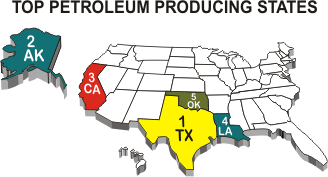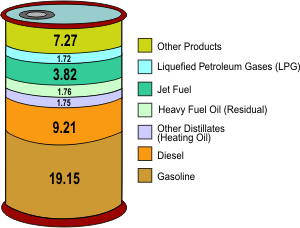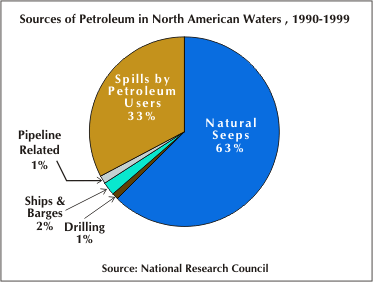|
Oil
Fuel
See
also:
other
readings with assessment in Alternative Energy -- Wind
Energy -- Geothermal Energy -- Hydropower -- Nuclear Energy
--
see
Alternative Energy Basics
|
|
|
How Was Oil
Formed?
Oil was formed
from the remains of animals and plants that lived millions of years
ago in a marine (water) environment before the dinosaurs.
Over the years, the remains were covered by layers of mud.
Heat and pressure from these layers helped the remains turn into
what we today call crude oil . The word "petroleum" means
"rock oil" or "oil from the earth."

Where
Do We Get Our Oil?
Crude oil is
a smelly, yellow-to-black liquid and is usually found in underground
areas called reservoirs. Scientists and engineers explore
a chosen area by studying rock samples from the earth. Measurements
are taken, and, if the site seems promising, drilling begins.
Above the hole, a structure called a 'derrick' is built to house
the tools and pipes going into the well. When finished, the
drilled well will bring a steady flow of oil to the surface.
The world's
top five crude oil-producing countries are:
- Saudi Arabia
- Russia
- United
States
- Iran
- China
Over one-fourth
of the crude oil produced in the United States is produced offshore
in the Gulf of Mexico. The top crude oil-producing states are:

- Texas
- Alaska
- California
- Louisiana
- Oklahoma
The amount
of crude oil produced (domestically) in the United States has
been getting smaller each year. However, the use of
products made from crude oil has been growing, making it necessary
to bring more oil from other countries. About 58 percent
of the crude oil and petroleum products used in the United States
comes from other countries.
What
Fuels Are Made From Crude Oil?
Products
Made from a Barrel of Crude Oil
(Gallons)
 After crude oil is removed from the ground, it is sent to a refinery
by pipeline, ship or barge. At a refinery,
different parts of the crude oil are separated into useable petroleum
products. Crude oil is measured in barrels (abbreviated "bbls").
A 42-U.S.
gallon barrel of crude oil provides slightly more than 44 gallons
of petroleum products. This gain from processing the crude
oil is similar to what happens to popcorn, it gets bigger after
it is popped. After crude oil is removed from the ground, it is sent to a refinery
by pipeline, ship or barge. At a refinery,
different parts of the crude oil are separated into useable petroleum
products. Crude oil is measured in barrels (abbreviated "bbls").
A 42-U.S.
gallon barrel of crude oil provides slightly more than 44 gallons
of petroleum products. This gain from processing the crude
oil is similar to what happens to popcorn, it gets bigger after
it is popped.
note: The gain from processing is more
than 5%.
One barrel of
crude oil, when refined,
produces about 20 gallons of finished motor
gasoline, and 7 gallons of diesel,
as well as other petroleum products. Most of the petroleum
products are used to produce energy. For instance, many people
across the United States use propane
to heat their homes and fuel their cars. Other products made
from petroleum include: ink, crayons, bubble gum, dishwashing liquids,
deodorant, eyeglasses, records, tires, ammonia, and heart valves.

How
Does Oil Impact The Environment?
Products from
oil (petroleum products) help us do many things. We use them to
fuel our airplanes, cars, and trucks, to heat our homes, and to
make products like medicines and plastics. Even though petroleum
products make life easier - finding, producing, moving, and using
them can cause problems for our environment like air and water pollution.
Over the years, new technologies and laws have helped to reduce
problems related to petroleum products. As with any industry, the
government monitors how oil is produced, refined, stored, and sent
to market to reduce the impact on the environment. Since 1990, fuels
like gasoline and diesel fuel have also been improved so that they
produce less pollution when we use them.
Exploring and
drilling for oil may disturb land and ocean habitats. New technologies
have greatly reduced the number and size of areas disturbed by drilling,
sometimes called "footprints." Satellites, global positioning systems,
remote sensing devices, and 3-D and 4-D seismic technologies, make
it possible to discover oil reserves while drilling fewer wells.
Plus, the use of horizontal and directional drilling make it possible
for a single well to produce oil from much bigger areas. Today's
production footprints are only about one-fourth the size of those
30 years ago, due to the development of movable drilling rigs and
smaller "slimhole" drilling rigs. When the oil in a well is gone,
the well must be plugged below ground, making it hard to tell that
it was ever there. As part of the "rig-to-reefs" program, some old
offshore rigs are toppled and left on the sea floor to become artificial
reefs that attract fish and other marine life. Within six months
to a year after a rig is toppled, it becomes covered with barnacles,
coral, sponges, clams, and other sea creatures.

If oil is spilled
into rivers or oceans it can harm wildlife.When we talk about "oil
spills" people usually think about oil that leaks from ships when
they crash. Although this type of spill can cause the biggest shock
to wildlife because so much oil is released at one time, only 2
percent of all oil in the sea comes from ship or barge spills. The
amount of oil spilled from ships dropped a lot during the 1990's
partly because new ships were required to have a "double-hull" lining
to protect against spills. While oil spills from ships are the most
well-known problem with oil, more oil actually gets into water from
natural oil seeps coming from the ocean floor. Or, from leaks that
happen when we use petroleum products on land. For example, gasoline
that sometimes drips onto the ground when people are filling their
gas tanks, motor oil that gets thrown away after an oil change,
or fuel that escapes from a leaky storage tank. When it rains, the
spilled products get washed into the gutter and eventually go to
rivers and the ocean. Another way that oil sometimes gets into water
is when fuel is leaked from motorboats and jet skis.
A refinery is
a factory where crude oil is processed into petroleum products.
Because many different pollutants can escape from refineries into
the air, the government monitors refineries and other factories
to make sure that they meet environmental standards.
When a leak
in a storage tank or pipeline occurs, petroleum products can also
get into the ground, and the ground must be cleaned up. To prevent
leaks from underground storage tanks, all buried tanks are supposed
to be replaced by tanks with a double-lining. This hasn't happened
everywhere yet. In some places where gasoline leaked from storage
tanks, one of the gasoline ingredients called methyl tertiary butyl
ether (MTBE) made its way into local water supplies. Since MTBE
made water taste bad and many people were worried about drinking
it, a number of states banned the use of MTBE in gasoline, and the
refining industry voluntarily moved away from using it when blending
reformulated gasoline.
Gasoline is
used in cars, diesel fuel is used in trucks, and heating oil is
used to heat our homes. When petroleum products are burned as fuel,
they give off carbon dioxide, a greenhouse gas
that is linked with global warming. The use of petroleum products
also gives off pollutants - carbon monoxide, nitrogen oxides, particulate
matter, and unburned hydrocarbons - that help form air pollution.
Since a lot of air pollution comes from cars and trucks, many environmental
laws have been aimed at changing the make-up of gasoline and diesel
fuel so that they produce fewer emissions. These "reformulated fuels"
are much cleaner-burning than gasoline and diesel fuel were in 1990.
In the next few years, the amount of sulfur contained in gasoline
and diesel fuel will be reduced dramatically so that they can be
used with new, less-polluting engine technology.
TEST
YOUR KNOWLEDGE OF THE MATERIAL
|

